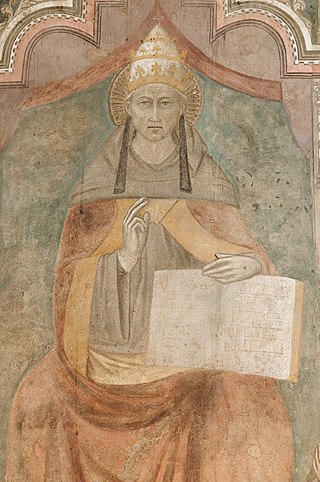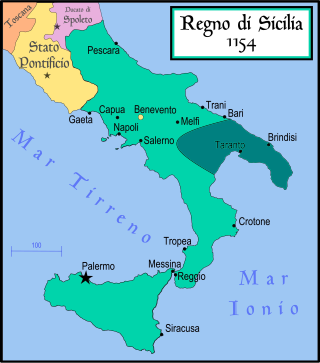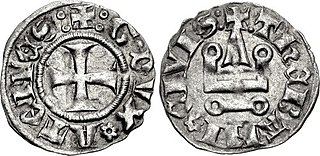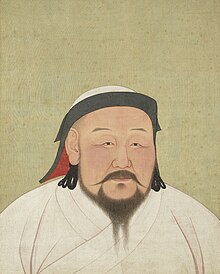
Pope Celestine V, born Pietro Angelerio, also known as Pietro da Morrone, Peter of Morrone, and Peter Celestine, was head of the Catholic Church and ruler of the Papal States for five months from 5 July to 13 December 1294, when he resigned. He was also a monk and hermit who founded the order of the Celestines as a branch of the Benedictine order.

Year 1215 (MCCXV) was a common year starting on Thursday of the Julian calendar.
The 1250s decade ran from January 1, 1250, to December 31, 1259.
The 1290s was a decade of the Julian Calendar which began on January 1, 1290, and ended on December 31, 1299.
Year 1296 (MCCXCVI) was a leap year starting on Sunday of the Julian calendar.

Year 1241 (MCCXLI) was a common year starting on Tuesday of the Julian calendar.

Year 1265 (MCCLXV) was a common year starting on Thursday of the Julian calendar.
Robert Winchelsey was an English Catholic theologian and Archbishop of Canterbury. He studied at the universities of Paris and Oxford, and later taught at both. Influenced by Thomas Aquinas, he was a scholastic theologian.

Brunetto Latini was an Italian philosopher, scholar, notary, politician and statesman.

Öljeyitü Khan, born Temür, also known by his temple name as the Emperor Chengzong of Yuan, was the second emperor of the Yuan dynasty of China, ruling from May 10, 1294 to February 10, 1307. Apart from Emperor of China, he is considered as the sixth Great Khan of the Mongol Empire, although it was only nominal due to the division of the empire. He was an able ruler of the Yuan dynasty, and his reign established the patterns of power for the next few decades.

The Principality of Taranto was a state in southern Italy created in 1088 for Bohemond I, eldest son of Robert Guiscard, as part of the peace between him and his younger brother Roger Borsa after a dispute over the succession to the Duchy of Apulia.
Robert of Durazzo was the third son of John, Duke of Durazzo and Agnes de Périgord.

John of Gravina, also known as John of Anjou, was Count of Gravina 1315–1336, Prince of Achaea 1318–1332, Duke of Durazzo 1332–1336 and ruler of the Kingdom of Albania. He was the youngest son of King Charles II of Naples and Mary of Hungary.

Guy II de la Roche, also known as Guyot or Guidotto, was the Duke of Athens from 1287, the last duke of his family. He succeeded as a minor on the death of his father, William I, at a time when the duchy of Athens had exceeded the Principality of Achaea in wealth, power, and importance.

The Capetian House of Anjou, or House of Anjou-Sicily, was a royal house and cadet branch of the direct French House of Capet, part of the Capetian dynasty. It is one of three separate royal houses referred to as Angevin, meaning "from Anjou" in France. Founded by Charles I of Anjou, the youngest son of Louis VIII of France, the Capetian king first ruled the Kingdom of Sicily during the 13th century. The War of the Sicilian Vespers later forced him out of the island of Sicily, which left him with the southern half of the Italian Peninsula, the Kingdom of Naples. The house and its various branches would go on to influence much of the history of Southern and Central Europe during the Middle Ages until it became extinct in 1435.
The counts of Gravina, later the dukes of Gravina, were medieval rulers of Gravina in Puglia, in the old Kingdom of Sicily and the Kingdom of Naples. The county was settled on various royal favorites, and was held by members of the Neapolitan royal family from about 1300 until 1385. In 1417, it was granted to Francesco Orsini, who was created a duke in 1436; his descendant holds the title today, and represents the remaining branch of the Orsini family. Among the Orsini dukes, Pietro Francesco resigned his temporal dignities in 1667 to become a Dominican, and subsequently ascended the papal throne as Pope Benedict XIII. His nephew, Duke Domenico II, was created cardinal. Francesco also achieved notoriety by being strangled while a captive of Cesare Borgia.

The 1292–94 papal election, was the last papal election which did not take the form of a papal conclave. After the death of Pope Nicholas IV on 4 April 1292, the eleven surviving cardinals deliberated for more than two years before electing the third of six non-cardinals to be elected pope during the Late Middle Ages: Pietro da Morrone, who took the name Pope Celestine V.
The Yuan dynasty (1271–1368) was a dynasty of China ruled by the Mongol Borjigin clan. Founded by Kublai Khan, it is considered one of the successors to the Mongol Empire.
The division of the Mongol Empire began after Möngke Khan died in 1259 in the siege of Diaoyu Castle with no declared successor, precipitating infighting between members of the Tolui family line for the title of khagan that escalated into the Toluid Civil War. This civil war, along with the Berke–Hulagu war and the subsequent Kaidu–Kublai war, greatly weakened the authority of the great khan over the entirety of the Mongol Empire, and the empire fractured into four khanates: the Golden Horde in Eastern Europe, the Chagatai Khanate in Central Asia, the Ilkhanate in Southwest Asia, and the Yuan dynasty in East Asia based in modern-day Beijing – although the Yuan emperors held the nominal title of khagan of the empire. The four divisions each pursued their own interests and objectives and fell at different times. Most of the western khanates did not recognize Kublai as Great Khan. Although some of them still asked Kublai to confirm the enthronement of their new regional khans, the four khanates were functionally independent sovereign states. The Ilkhanate and the Yuan dynasty had close diplomatic relations, and shared scientific and cultural knowledge, but military cooperation between all four Mongol khanates would never occur again — the united Mongol Empire had disintegrated.










